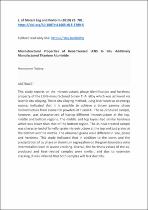 ResearchSpace
ResearchSpace
Microstructural Properties of Heat-Treated LENS In Situ Additively Manufactured Titanium Aluminide
JavaScript is disabled for your browser. Some features of this site may not work without it.
- ResearchSpace
- →
- Research Publications/Outputs
- →
- Journal Articles
- →
- View Item
| dc.contributor.author |
Tlotleng, Monnamme

|
|
| dc.date.accessioned | 2019-11-27T09:44:28Z | |
| dc.date.available | 2019-11-27T09:44:28Z | |
| dc.date.issued | 2019-02 | |
| dc.identifier.citation | Tlotleng, M. 2019. Microstructural Properties of Heat-Treated LENS In Situ Additively Manufactured Titanium Aluminide. Journal of Materials Engineering and Performance, vol. 28(2): 701-708 | en_US |
| dc.identifier.issn | 1059-9495 | |
| dc.identifier.issn | 1544-1024 | |
| dc.identifier.uri | https://link.springer.com/article/10.1007/s11665-018-3789-5 | |
| dc.identifier.uri | https://doi.org/10.1007/s11665-018-3789-5 | |
| dc.identifier.uri | https://rdcu.be/bXJPq | |
| dc.identifier.uri | http://hdl.handle.net/10204/11235 | |
| dc.description | Copyright: 2019 Springer. Due to copyright restrictions, the attached PDF file only contains the abstract of the full text item. For access to the full text item, please consult the publisher's website: https://doi.org/10.1007/s11665-018-3789-5 A free fulltext non-print version of the article can be viewed at https://rdcu.be/bXJPq | en_US |
| dc.description.abstract | This study reports on the microstructure, phase identification and hardness property of the LENS-manufactured binary Ti-Al alloy which was achieved via laser in situ alloying. The in situ alloying method, using laser beam as an energy source, indicated that it is possible to achieve a binary gamma phase microstructure from elemental powders of Ti and Al. The as-produced sample, however, was characterized of having different microstructure at the top, middle and bottom regions. The middle and top layers had similar hardness which was lower than that of the bottom region. The as heat-treated sample was characterized of lamellar grain microstructure at the top and just grains at the bottom and the middle. The observed grains were different in size, phase and hardness. This study indicated that in addition to the pores and the precipitation of a2 phase or aluminum segregation on the grain boundary veins intermetallics lead to severe cracking. Overall, the hardness values of the as-produced and heat-treated samples were similar, and due to extensive cracking, it was inferred that both samples will lack ductility. | en_US |
| dc.language.iso | en | en_US |
| dc.publisher | Springer | en_US |
| dc.relation.ispartofseries | Worklist;22801 | |
| dc.subject | Additive manufacturing | en_US |
| dc.subject | Direct energy deposition | en_US |
| dc.subject | Hardness | en_US |
| dc.subject | LENS | en_US |
| dc.subject | Laser in situ alloying | en_US |
| dc.subject | Titanium aluminides | en_US |
| dc.subject | c + a2 phase | en_US |
| dc.title | Microstructural Properties of Heat-Treated LENS In Situ Additively Manufactured Titanium Aluminide | en_US |
| dc.type | Article | en_US |
| dc.identifier.apacitation | Tlotleng, M. (2019). Microstructural Properties of Heat-Treated LENS In Situ Additively Manufactured Titanium Aluminide. http://hdl.handle.net/10204/11235 | en_ZA |
| dc.identifier.chicagocitation | Tlotleng, Monnamme "Microstructural Properties of Heat-Treated LENS In Situ Additively Manufactured Titanium Aluminide." (2019) http://hdl.handle.net/10204/11235 | en_ZA |
| dc.identifier.vancouvercitation | Tlotleng M. Microstructural Properties of Heat-Treated LENS In Situ Additively Manufactured Titanium Aluminide. 2019; http://hdl.handle.net/10204/11235. | en_ZA |
| dc.identifier.ris | TY - Article AU - Tlotleng, Monnamme AB - This study reports on the microstructure, phase identification and hardness property of the LENS-manufactured binary Ti-Al alloy which was achieved via laser in situ alloying. The in situ alloying method, using laser beam as an energy source, indicated that it is possible to achieve a binary gamma phase microstructure from elemental powders of Ti and Al. The as-produced sample, however, was characterized of having different microstructure at the top, middle and bottom regions. The middle and top layers had similar hardness which was lower than that of the bottom region. The as heat-treated sample was characterized of lamellar grain microstructure at the top and just grains at the bottom and the middle. The observed grains were different in size, phase and hardness. This study indicated that in addition to the pores and the precipitation of a2 phase or aluminum segregation on the grain boundary veins intermetallics lead to severe cracking. Overall, the hardness values of the as-produced and heat-treated samples were similar, and due to extensive cracking, it was inferred that both samples will lack ductility. DA - 2019-02 DB - ResearchSpace DP - CSIR KW - Additive manufacturing KW - Direct energy deposition KW - Hardness KW - LENS KW - Laser in situ alloying KW - Titanium aluminides KW - c + a2 phase LK - https://researchspace.csir.co.za PY - 2019 SM - 1059-9495 SM - 1544-1024 T1 - Microstructural Properties of Heat-Treated LENS In Situ Additively Manufactured Titanium Aluminide TI - Microstructural Properties of Heat-Treated LENS In Situ Additively Manufactured Titanium Aluminide UR - http://hdl.handle.net/10204/11235 ER - | en_ZA |





